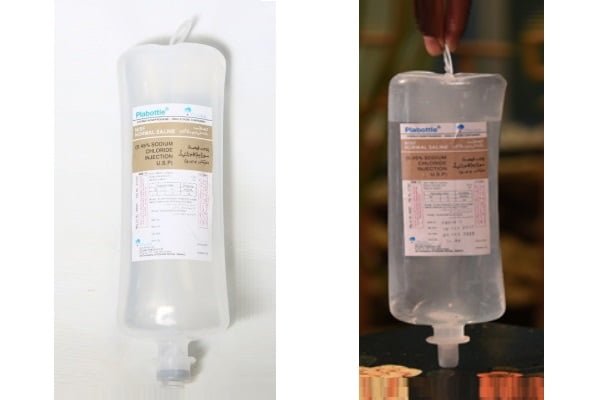As the human body is extensively made up of water in the form of electrolyte solution, some patients may require replenishment in certain health conditions. In such cases, one of the commercially available electrolyte solutions is chosen to be administered for a particular application. Two of these solutions are the lactated Ringers solution and the normal saline.

Lactated Ringers solution or normal saline in a drip set
Lactated Ringers solution
The lactated ringers solution is a sterile solution containing multiple electrolytes in varying concentrations. It is one of the widely used solutions in medical therapy on an everyday basis. The lactated Ringers solution has multiple benefits which are the basis of its vast applications.

Lactated Ringers solution
Composition of lactated Ringers solution
Every 100 ml of lactated Ringers solution contains:
- Water
- Sodium lactate: 0.31 grams
- Sodium chloride: 0.6 grams
- Potassium chloride: 0.03 grams
- Calcium chloride: 0.02 grams
The composition of the lactated Ringers solution may vary with the manufacturer.
Applications of lactated Ringers solution
The lactated Ringers solution has the following applications in the field of therapeutics:
- It is given as a treatment for dehydration.
- The lactated Ringers solution is used to irrigate wounds, bladder, or other surgical areas.
- It is helpful in keeping a vein open while an IV catheter has been placed in it.
- It is used to reduce the acidity during sepsis as the sodium lactate which, upon disintegration, generates bicarbonate ions to help neutralize the acid.
- Lactated Ringer’s solution finds applications in the replenishment of lost body fluids during trauma, burns, blood loss, or an injury.
Dose of lactated Ringers solution
The dose of the lactated Ringers solution may vary depending upon the condition of the patient as well as the purpose of application. Normally, a physician may intravenously administer lactated Ringers solution as a KVO which means to ‘keep vein open’ at a rate of 30 ml per hour. However, if needed, a dose of 1000 ml per hour can also be given.
Side effects of lactated Ringers solution
Too much administration of the lactated Ringers solution can cause the following issues:
- Swelling of the face or the body in general
- Edema i.e. accumulation of the fluid inside the body
- Depletion of sodium and potassium levels in the blood
Precautions
Although the lactated Ringers solution can be used in the following cases, constant monitoring of the patient’s condition is highly recommended:
- It is not ideal to use the lactated Ringers solution in a patient with a pH greater than 7.5.
- It is not ideal to use lactated Ringers solution in patients with hypersensitivities to corn as the lactated Ringers solution may contain dextrose.
- Due to having calcium, it is not suitable for people having a blood transfusion as blood clots may be formed.
- Chronic kidney
- Cirrhosis. is a condition in which the liver tissue is scarred.
- Hypoalbuminemia. is a reduction in albumin concentration which is a protein responsible for keeping fluids inside the blood vessels.
- Congestive heart failure. a type of heart failure in which the heart is unable to pump the blood filled in it.
Normal saline (NS)
Normal saline, abbreviated as NS or SN, is an aqueous electrolyte solution containing sodium chloride.

Normal saline (NS)
Composition of normal saline
Normal saline is 0.9% saline solution which means it contains 0.9 grams of NaCl per 100 ml of the solution or 9 grams per liter. The solution has 154 mEq of sodium and chloride ions per liter of solution or 15.4 mEq per 100 ml.
Applications of normal saline
The normal saline finds vast applications in the following:
- Drugs such as nitroglycerin, nitroprusside, propranolol, norepinephrine, and methylprednisolone easily mix with normal saline, unlike lactated Ringers solution, to give stable solutions.
- It can be used for the treatment of dehydration i.e. hypovolemia.
- Normal saline is employed for the treatment of shock.
- It can also be utilized for the treatment of metabolic alkalosis.
- Normal saline can treat sodium depletion.
Side effects of normal saline
The normal saline, although safe to use, has the following side effects:
- The higher concentration of chloride ions generated by the dissociation of sodium chloride can result in renal vasoconstriction which ultimately reduces the blood flow toward the kidneys.
- In case of too much NS administration, the patient may show swelling of the extremities.
- Poor wound healing, hypertension, and respiratory failure are also associated with fluid overload.
Precautions
It is preferable to avoid the use of normal saline in the following conditions:
- Heart diseases
- Kidney diseases
- Hyperchloremia i.e. higher levels of chloride ions in the body
- Fluid volume overload i.e. having too much water in the body
Comparison between the lactated Ringers solution and Normal saline
The lactated Ringers solution as well as the normal saline are widely used solutions in hospitals. Although they do share commonalities, differences between them also exist.
Similarities
- Both are given via the IV route
- Both are isotonic with the blood i.e. they do not harm the blood and body cells by rupturing or shrinking them.
Differences
- Both solutions vary in their compositions and use. The lactated Ringers solution has calcium and lactate ions among others but the normal saline is only based on sodium and chloride ions.
- The osmolarity of the lactated Ringers solution is 273 mOsm/L while that of normal saline is 286 mOsm/L.
Conclusion
Both the lactated Ringers solution and the normal saline are frequently used in hospitals. Although both the solutions vary widely in their compositions along with their applications, they do share some common uses such as the replenishment of body fluids after trauma or injury. Both solutions can also be used as irrigation solutions for wounds. Moreover, their use as a base for various drugs is well known. Hence, both the lactated Ringers solutions, as well as the normal saline, are of great importance.

PhD Scholar (Pharmaceutics), MPhil (Pharmaceutics), Pharm D, B. Sc.
Uzma Zafar is a dedicated and highly motivated pharmaceutical professional currently pursuing her PhD in Pharmaceutics at the Punjab University College of Pharmacy, University of the Punjab. With a comprehensive academic and research background, Uzma has consistently excelled in her studies, securing first division throughout her educational journey.
Uzma’s passion for the pharmaceutical field is evident from her active engagement during her Doctor of Pharmacy (Pharm.D) program, where she not only mastered industrial techniques and clinical case studies but also delved into marketing strategies and management skills.
Throughout her career, Uzma has actively contributed to the pharmaceutical sciences, with specific research on suspension formulation and Hepatitis C risk factors and side effects. Additionally, Uzma has lent her expertise to review and fact-check articles for the Health Supply 770 blog, ensuring the accuracy and reliability of the information presented.
As she continues her PhD, expected to complete in 2025, Uzma is eager to contribute further to the field by combining her deep knowledge of pharmaceutics with real-world applications to meet global professional standards and challenges.








